solar
Nothing Like the Sun

On October 28, Wired ran this bit on NYC’s new solar powered subway station:
“On a sunny day, 60,000 square feet of integrated solar paneling on its roof can generate 210 kilowatts of power, enough to meet two-thirds of the station’s energy requirements. The solar energy doesn’t run the trains, but is expected to contribute approximately 250,000 solar kilowatt hours per year to the station’s other energy needs — primarily lighting and air conditioning in the station and its attached offices and retail stores....
In addition to the Stillwell station, photovoltaic, or PV, cells help power a bus terminal and rail yard in Queens, as well as the Whitehall Ferry Terminal at the southern tip of Manhattan.”
OK, pretty cool. (But are we subsidizing those retail stores? Or are they paying the MTA for the juice?)
And of note is this little factoid:
“Total renovation costs approached $300 million, though it’s not clear how much of that came from expenses related to the solar roof.”
OK, pricey, but these things stick around a while. And of course, there’s the MTA’s $1 billion dollar surplus this year.
But it all puts into further context the MTA’s last minute demand that pushed the union to strike.
From today’s NY Times we learn that in the final minutes before the midnight deadline for negotations, the MTA changed their “final offer”, and pushed a demand to cut the wages of new workers by 4 percent. The plan would have the union win current benefits at the expense of future members (a classic tactic of employers negotiating with unions) and save less than $20 million over three years:
“less over the next three years than what the New York City Police Department will spend on extra overtime during the first two days of the strike.”
Designing for the Dispossessed
From The New York Times, August 28, 2003:
“Designing for the Dispossessed
by Alastair Gordon
At age 29, Cameron Sinclair was among the youngest speakers at the International Design Conference in Aspen, Colo., last week. He nonetheless brought a full auditorium to its feet Thursday morning with a review of his work with Architecture for Humanity, a nonprofit organization he started from his Manhattan studio apartment with a scattering of volunteers and a shoestring budget.
Over the last four years, Mr. Sinclair’s group has helped generate programs and designs for disaster relief in 20 countries, including Afghanistan, Kosovo and South Africa.
Mr. Sinclair’s talk, peppered with well-rehearsed lines (‘All I ask is that they design like they give a damn’) was tailor-made for a design conference that took global concerns with safety as its theme.
‘He has been a mainstay and hero of the conference,’ said Paola Antonelli, a curator at the Museum of Modern Art in New York and a chairwoman of the conference. ‘He’s asking architects to take a risk and forget about immediate profits.’
Mr. Sinclair’s appearance alongside more established design figures is evidence of a shift, particularly among students and younger designers, toward social responsibility.
‘Would someone like me have been invited to speak here five years ago?’ Mr. Sinclair said. ‘Probably not. But a lot of younger architects don’t want to design doorknobs in boutique hotels anymore. They want to be engaged, they want to help find solutions to critical problems.’
Of course, Mr. Sinclair is not the only one generating designs for relief. The Rural Studio, based in Auburn, Ala., has helped provide housing for the rural poor since 1993, and Shelter for Life, a volunteer group based in Oshkosh, Wis., has built houses in Afghanistan. But through persistence, personal charm and a marriage to a journalist who writes press releases and grant proposals, Mr. Sinclair has managed to make himself the center of a global network of designers, engineers and relief groups.
Mr. Sinclair and his wife, Kate Stohr, 29, have gone a long way with limited means. He was laid off from his job as a project architect at Gensler a year ago, and has devoted himself to Architecture for Humanity full time ever since. ‘Here we are doing health programs around the world,’ he said. ‘And we can’t afford health insurance for ourselves.’
Four days after 9/11, the United Nations High Commission for Refugees called Mr. Sinclair, he said, to tell him he was on a list of people that could be asked to help with the coming relief effort in Afghanistan. ‘I told them I hope it’s a long list,’ he said, ‘because I’m a 28-year-old alone in my apartment.’ (He put them in contact with architects and engineers in Pakistan and other neighboring countries.)
During the 1960’s and early 70’s, young architects as a rule felt almost obliged to address issues like affordable housing and community planning. But by the time Mr. Cameron arrived at the Bartlett School of Architecture in London in the late 1990’s, these concerns had given way to a preoccupation with signature design and theory.
‘I was the black sheep of my class,’ said Mr. Sinclair, who designed housing for the homeless as his thesis project. ‘My fellow students were more interested in getting into Wallpaper magazine.’
He does not feel like a black sheep anymore. In the past two months, more than 120 people have applied to work for him as unpaid interns, most of whom had to be turned away.
‘A lot of my generation is disillusioned,’ Mr. Sinclair said.
‘You finish school, start with a big firm, and become a CAD monkey working in a little cubicle,’ he added, referring to computer-animated design. ‘You’re told that only one out of a hundred will make it as a name architect. That’s depressing.’
Mr. Sinclair, who was raised in London, showed his organizational knack two years ago when he founded the ‘Uncoordinated Soccer League’ in New York for unathletic designers, a dozen of whom ended up volunteering for his group.
In 1999, with a budget of just $700, Mr. Cameron held a competition to design transitional housing for refugees returning to Kosovo. He received nearly 300 entries from 30 countries, including a modern yurt built around a central column by the Oakland-based firm Basak Altan Design. ‘Refugee shelter is usually a last-minute, ad hoc affair with little in the way of advance planning,’ Mr. Sinclair said. His goal was to provide shelters where refugees could live for years while rebuilding homes.
The jury, which included the architects Tod Williams, Billie Tsien and Steven Holl, picked 10 winners. Five prototypes were built, including a structure made of paper by Shigeru Ban of Tokyo and a shipping container lined with plywood by the Australian architect Sean Godsell.
Gans & Jelacic, a firm in New York, built a prototype of their entry, a triangular structure that pops up from a container with the help of a standard car jack.
I-Beam Design, another New York firm, designed a shelter made from wooden shipping pallets. ‘We were looking for a simple solution and realized that supplies sent to disaster areas are often shipped on these pallets,’ said Azin Valy of I-Beam. ‘We wanted a universal system that a child could put together.’
Ms. Valy and her partner, Suzan Wines, built a prototype in an abandoned lot in the South Bronx. Within weeks, a homeless man had moved in; and a week after that, the city had torn it down.
For all his persuasive ways, Mr. Sinclair has so far failed to actually build anything in Kosovo. He is among the first to acknowledge the failure. ‘We architects enjoy a pat on the back, but unless you build it, it’s just an idea,’ he said.
However thoughtful they may be, designs intended for developing countries often fail to consider local conditions. Muslim countries, for example, typically require separate facilities for men and women. Steel shipping containers, used in several submissions, may, in fact, be unsuitable in tropical climates. And structures that are hard to assemble are of limited use when recipients are largely women, children and older men.
‘It’s important that architects consult with the beneficiaries, which seems obvious, but this doesn’t always occur,’ said Erin Mooney, deputy director of a project on displaced people for the Brookings Institution and Johns Hopkins University.
Gans & Jelacic were one of the few who went into the field. Deborah Gans attended the Refugee Studies Center at Oxford University while her partner, Matthew Jelacic, visited refugee camps in Bosnia. There, tents outside Sarajevo had collapsed under snowfall.
Mr. Sinclair and Ms. Stohr married while organizing the Kosovo competition, and they left shortly afterward for a monthlong honeymoon in South Africa. ‘The honeymoon lasted two days,’ Mr. Sinclair said. While his wife began reporting an article on a rape epidemic in South Africa, later published in The Pittsburgh Post-Gazette, Mr. Sinclair met with urban planners and visited shantytowns.
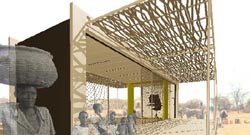 Two and a half years later, in May of 2002, Mr. Sinclair staged a competition for mobile medical clinics that could be used to treat AIDS in Africa. He received more than 530 submissions from 51 countries. (An exhibition of entries is touring five countries, ending with South Africa.)
Two and a half years later, in May of 2002, Mr. Sinclair staged a competition for mobile medical clinics that could be used to treat AIDS in Africa. He received more than 530 submissions from 51 countries. (An exhibition of entries is touring five countries, ending with South Africa.)
The proposal that won first place, by jury, is a self-sufficient clinic with a satellite dish, solar power and a water collection system. The clinic, designed by Khras Architects of Denmark, would be made from a lightweight metal skeleton with natural materials added for local texture.
‘Instead of one solution we wanted to come up with a system,’ said Mads Hansen, a member of the Khras team. ‘In Africa, especially in remote areas, you don’t just get a spare part from down the road.’
Mr. Sinclair is trying to raise $20,000 to send four finalists to meet with doctors and relief workers in South Africa before building prototypes.
‘Architects pride themselves on having a vision of the future, but in this case they’re not rising to the crisis,’ said Rodney Harber, an architect in Durban, South Africa, who has worked on AIDS-related projects for 10 years. ‘Cameron has made a real contribution. His competitions and Web site have helped to stimulate a global dialog.’
Mr. Sinclair and Ms. Stohr see their role over the next few years as advocates, shepherding their various projects to completion. ‘I’m hoping to one day watch the sun set in Africa while we sit on the porch of our mobile health clinic,’ Ms. Stohr said.”
Some interesting ideas in the mix. In 2002, I visited the church / community center built of cardboard tubes that Shigeru Ban constructed in Kobe after the horrible earthquake of 1995. It was still standing and very much in use.
The winning clinic is designed so it can be locally built, run, and maintained. The design criteria for the mobile clinic are as follows:
- The unit should adequately house, transport and be easily operable by a small team of medical professionals (2 to 5). Storage of equipment and medical supplies should be taken into consideration.
- The clinic should be cost-effective. If possible it should be built using sustainable materials and construction techniques. Designers can make use of either advanced or simple technologies and should look to take advantage of local materials, construction techniques and labor.
- The unit should be mobile and durable enough to be transported through widely diverse areas of Sub-Saharan Africa. Topography and terrain should be taken into account. Ease of maintenance and repair are essential.
- Entrants should take into consideration the tasks performed within the clinic. Although the unit will primarily be used for the prevention, testing and treatment of the virus and associated infections, it must also be a place where health care professionals can teach and disseminate information.
- In addition to HIV/AIDS, many other deadly but treatable diseases afflict the African continent, chief among them tuberculosis and malaria. The ideal design will take into account the varying health care needs of the population and should be easily adapted to treat these other diseases and conditions.
- One of the major obstacles is the stigma surrounding the disease and this should be taken into strong consideration when designing. If a clinic arrives into a remote area for the first time, think how it will be received into the community.
- Finally, the ideal design will also create opportunities for economic growth. Many of the regions deeply affected by HIV/AIDS have suffered economically to the point of reverse development. In addition to becoming a highly dispersed health care distribution network, designers are encouraged to pursue ways of providing complimentary or secondary services in addition to health care via the same mobile unit.
It’s great to see the power a couple of individuals can have to promote the design in the public interest.
Still, it’s unfortunate that it is so apolitical. Better treatment and a few more rural health clinics is a good thing, but clinic design does not address public health policy, or the economic, social, and cultural factors propelling the AIDS epidemic. There are plenty of clinics in the West, and yet the epidemic continues. I wonder if the Africa clinics will be used for to test those Western AIDS vaccines, too.
I also wonder if participation in the competitions will radicalize the architects in their own countries. With members in 75 countries around the world, such a network could, for instance, join the movement to keep international pressure on the WTO to change drug patent rules that keep cheap drugs out of the hands those who need them. Those architects around the world could push their countries to forgive foreign debt in Africa. With debt relief, governments in Africa could fund their own health programs rather than spending their budgets on interest payments, and relying on still more loans and donations to support such public health initiatives.... loans from international lending agencies that in many cases require the dismantlement of public health programs.
Pocket Full of Sunshine
Just after sunset, the lights come back on to applause in the street. Email checked, I should probably write something about design and the last 24 hours in New York City. Something about flashlights, candles, and radios; bridges and tunnels, skyscrapers, and long walks home; acoustic guitars, drums, and old clarinets; block parties and bon fires; cellular, cordless, analog and pay phones, and just plain hollerin from the street; public parks in times of crisis, generators and hot dogs, gas-burning pizza ovens, second-hand books, cool breezes, and a long nap on an August afternoon; energy efficiency and sustainable design; infrastructure, ideology, and public policy; and the stars returning briefly to the night sky over Manhattan.
Instead, I’m going out to find something to eat.
I leave you with this:
Studio del Sole’s Violetta Solargear is a pocket-sized solar power charger for AA and AAA Ni-MH batteries. They also sell a USB extension and a DC adapter to power your mobile phone, PDA, music player, or Game Boy. A personal solar panel for your personal electronic device. It’s just so elegant.
Gaviotas

In 1965 Paulo Lugari was flying over the impoverished Llanos Orientales, the “eastern plains” that border Venezuela. The soil of the Llanos is tough and acidic, some of the worst in Colombia. Lugari mused that if people could live here they could live anywhere.
The following year Lugari and a group of scientists, artists, agronomists and engineers took the 15-hour journey along a tortuous route from Bogota to the Llanos Orientales to settle. The local population, including the indigenous Guahibo people, familiar with the political terror and violence of the ‘white man,’ were naturally suspicious.
Nearly 40 years later, while war rages across Colombia with the help of U.S. funds, equipment, and training, the 200 residents of Gaviotas, including farmers, scientists, artists, and former street kids, have created a thriving village and environmental research center in Vichada in Los Llanos.
“Gaviotas is named after a bird that enlivens the rivers at dusk.” [source]
“They have planted millions of trees, thus regenerating an indigenous rainforest. They farm organically and use wind and solar power. Every family enjoys free housing, community meals, and schooling. There are no weapons, no police, no jail. There is no mayor.” [source]
“Gaviotas provided a chance to plan a tropical civilization from the ground up, instead of depending on technologies developed for northern climates. ‘When we import solutions from the US or Europe,’ said Lugari, founder of Gaviotas, ‘we also import their problems.’
Over the years Gaviotas technicians have installed thousands of the windmills across Colombia - in some places gaviotas is the local word for windmill.”
Around 58 types of windmill were tried and tested before the pioneers came up with determined that the distinctive ‘sunflower’ design functioned best in the plains.
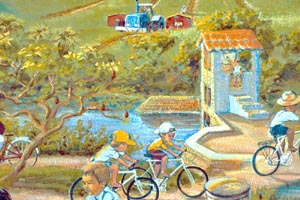 “Since Gaviotas refuses to patent inventions, preferring to share them freely, the design has been copied from Central America to Chile.
“Since Gaviotas refuses to patent inventions, preferring to share them freely, the design has been copied from Central America to Chile.
Electricity comes from a low-head turbine powered by a stream, except in the short dry season, when it is backed up by a diesel generator. ‘In 24 years we’ve learned to cover 70 percent of our food and energy needs,’ says Gonalo Bernal, administrator of Gaviotas. ‘The trees we plant more than compensate for any greenhouse gases we emit. Imagine if the rest of the world lived like us.’
Gaviotas began as a collection of researchers, students, and laborers sharing vehicles, bedding, dishes, clothes - and decisions. In time several of their families joined them and a permanent colony with individual houses emerged. Government was by consensus and unwritten rules. To limit public disorder, alcohol is confined to homes. To preserve wildlife, dogs and guns are banished. A need for police, jail, or door locks has never arisen. Anyone who violates protocol, like a storekeeper who recently admitted to overcharging, is ostracized by the community until his debt is paid. Loafers aren’t tolerated, but with wages above the Colombian minimum wage, plus free meals, medical care, schools, and housing, loafing isn’t a problem.
A techno-tour of the llanos shows how Gaviotas has revolutionized life here. The most significant invention is a simple hand pump capable of tapping aquifers six times deeper than conventional models, but requiring so little effort that children can operate it. In normal pumps a heavy piston must be raised and lowered inside a pipe. Gaviotas engineers realized they could do the reverse; leave the piston stationary and lift an outer sleeve of lightweight, inexpensive PVC tubing instead.”
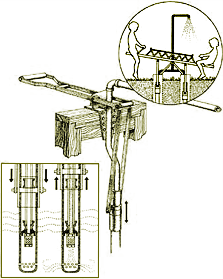 “In the open-air Gaviotas preschool, the children’s see-saw is actually a pump in disguise. As they rise and descend, water gushes from a vertical pipe into an open cement tank. Over the years Gaviotas technicians have installed these in thousands of school yards, using kid power to provide villages with clean water. This simple, inexpensive pump has revolutionised rural life across Colombia for people who used to haul their water in buckets from muddy tropical rivers.” [source]
“In the open-air Gaviotas preschool, the children’s see-saw is actually a pump in disguise. As they rise and descend, water gushes from a vertical pipe into an open cement tank. Over the years Gaviotas technicians have installed these in thousands of school yards, using kid power to provide villages with clean water. This simple, inexpensive pump has revolutionised rural life across Colombia for people who used to haul their water in buckets from muddy tropical rivers.” [source]
“At a windmill-fed cattle trough, surrounded by a sloping cement floor, cowboys have just brought several thirsty calves. As they drink, their dung slides down the slope into a gutter, which sluices it to an enclosed anaerobic fermentation tank, where the cow-pie slurry turns into compost and methane.
The methane flows through pipes to the 16-bed Gaviotas hospital, which a Japanese architectural journal has named one of the 40 most important buildings in the world. It is at once both futuristic and ancient, a maze of angles formed by white walls, glass awnings, skylights, brushed steel columns, and exposed supports trimmed in blue and yellow enamel. The interior is cooled with underground ducts whose hillside intakes face the prevailing breeze. Opposing layers of corrugated roofing create a series of air channels that further bleed away the heat. The combined effect is cost-free, maintenance-free air conditioning. Solar collectors on the roof alternately heat, boil, and distill water. Electricity is from solar photovoltaic cells.
The only hospital within a 12-hour radius, it serves all comers, including both guerrilla and army forces battling in the area. ‘The rule here is never to ask,’ says Bernal. ‘Like the Red Cross, everybody respects us.’
A short, vine-covered walkway connects the Gaviotas hospital to the maloks, a separate wing built by the local Guahivo Indians. Instead of beds, patients and their families lie in hammocks hung from wooden beams under a great thatch roof. Relatives of the sick tend crops of tomatoes, lettuce, and onions in an adjacent hydroponic greenhouse.
If the National University’s pharmacology department and the Guahivo shamans have their way, this greenhouse will one day become the finest medical plant laboratory in the tropics. But money is a critical factor, and Colombia’s expanding, government-owned oil and gas industry has dampened Gaviotas’ solar collector sales by blocking tax benefits for investing in alternative energy. At  the same time revenue from windmills and pumps dropped as Colombian agriculture was battered by an unexpected onslaught of cheap imported foods, the fallout of new free trade policies.
the same time revenue from windmills and pumps dropped as Colombian agriculture was battered by an unexpected onslaught of cheap imported foods, the fallout of new free trade policies.
So Gaviotas has decided to scale down its manufacturing. But no one is getting laid off. ‘Gaviotas isn’t a company,’ Lugari says, ‘we’re a community. In fact the solution means that both employment and Gaviotas will grow.’
The solution is the nearly 20,000 forested acres. In the past 12 years, Gaviotas has planted 1.6 million Caribbean pines (after finding that no indigenous tree would grow on the prairie). To the surprise of foresters, Gaviotans chose not to cut their standing timber. Instead they are converting their windmill factory to process pine resin. Colombia spends $4 million annually to import such resins for the manufacture of paint, turpentine, and paper. Armed with that fact, Lugari persuaded the Japanese government to provide the seed money, via a grant through the Interamerican Development Bank, to begin tapping and processing resin for the domestic market.” [source]
Since the above was written in 1995, the community no longer purhcases diesel fuel and is now totally energy independent. They generate power with turbine engines fueled by the resin of the Carribean pine trees in their forest. These pines are being slowly crowded out by the regeneration of indigenous rainforest. [source]
Other inventions include:
- a high pressure solar cooker
- methane burners
- hot-water solar panels
- parabolic solar grain driers
- self-cooling rooftops
- cooling wind corridors
- corkscrewing manual well digger
- variety of highly efficient and durable windmills
- specialized bicycle for the Llanos
- pedal powered cassava grinder (10 hours work done in 1 hour)
- rotating drum peanut sheller
- ox-drawn land graders
- one-handed sugarcane press
Gaviotas engineers also designed a solar kettle for the hospital. According to engineer Jaime Dávila, “the principle begins with an old country custom: boil water one day to drink the next, after it cools.” Dávila’s goal was an inexpensive solar-operated system that would give unlimited boiled drinking water, already cooled to room temperature, straight from a tap any time of day, and would work under cloudy skies. The kettle took six years to perfect. It combines solar panels, storage tanks, an efficient heat exchanger, a bit of distillation and a spigot — which you turn to draw off potable water.[source]
See some renderings of their solar collectors, solar oven, and wind-powered musical organ.
ISO 14001 Reconsidered
Reader Desmond B. writes:
“Browsing through your site, I was interested by your relatively neutral presentation of the ISO programme. You presented some interesting aspects of the bureaucratic inanities, as well as some of the difficulties of applying euro-centric standards (the symbology not being applicable worldwide) on a global scale. It seems as though there are many positive aspects to the ISO programme (your mention of Toyota’s practices), it appears that there is relatively little citizen/democratic control or oversight of this organisation. It’s one thing to standardise container sizes, but environmental management procedures should perhaps be a more public affair. Curious to see some critical comment from you regarding this, especially considering the frequent mentions of ISO on your site.”
True enough. In my two posts that mention the ISO I was fairly neutral. I was less concerned about democratic accountability of the ISO because the standard setting process is fairly open and decentralized, and standards compliance is entirely voluntary. It is up to governments, not the ISO, to legislate, regulate, or enforce implementation of the standards.
 Standards are developed by consensus of broad-based technical committees and working groups. According to the ISO site:
Standards are developed by consensus of broad-based technical committees and working groups. According to the ISO site:
“In these committees, qualified representatives of industry, research institutes, government authorities, consumer bodies, and international organizations from all over the world come together as equal partners in the resolution of global standardization problems.”
Though the views of these interests are taken into account in the standard development process, only ISO “member bodies” can actually participate in the final vote. A member body of ISO is the national body ‘most representative of standardization in its country’. Only one such body is accepted from each country.
That said, the ISO’s consensus process is becoming less open:
“As part of the streamlining of existing procedures, ISO committees will in future, subject to certain conditions, have the option of dispensing with the committee stage — the part of the ISO process during which national positions are debated in order to reach consensus within an ISO committee — and with the final approval stage, during which the texts of final standards are submitted for formal approval by the full ISO membership.” [source]
The ISO’s patent policy highlights the need for more public participation, accountability, and oversight.
The ISO requires individual or corporation’s holding patent rights on any part of an ISO standard to grant usage rights freely or under “reasonable and non-discriminatory terms and conditions” that apply throughout the world. While this may seem fair, the working committee of the relevant standard determines what is “reasonable and non-discriminatory.” This policy has kept some technical standards out of the public domain and from being implemented in some Free Software projects. For instance, it is impossible to write Free Software which can encode or decode MPEG-2 video or encode or decode MPEG-1 Layer 3 audio in the United States. When the organzation that sets standards for the Internet, the W3C, floated its own draft policy considering “reasonable and non-discriminatory” licensing fees, it was widely condemned in public comment and eventually dropped in favor of a draft with royalty-free licenses.
As Desmond notes, though, environmental management procedures are a different matter from, say, standard paper sizes.
The major requirements of an Environmental Management System (EMS) under ISO 14001 include:
- Issuing a policy statement which includes commitments to prevention of pollution, continual improvement of the EMS leading to improvements in overall environmental performance, and compliance with all applicable statutory and regulatory requirements.
- Identification of all aspects of the community organization’s activities, products, and services that could have a significant impact on the environment, including those that are not regulated
- Setting performance objectives and targets for the management system which link back to the three commitments established in the community or organization’s policy (i.e. prevention of pollution, continual improvement, and compliance)
- Implementing the EMS to meet these objectives. This includes activities like training of employees, establishing work instructions and practices, and establishing the actual metrics by which the objectives and targets will be measured.
- Establishing a program to periodically audit the operation of the EMS
- Checking and taking corrective and preventive actions when deviations from the EMS occur, including periodically evaluating the organization’s compliance with applicable regulatory requirements.
- Undertaking periodic reviews of the EMS by top management to ensure its continuing performance and making adjustments to it, as necessary. [source]
“ISO 14001 does not establish performance requirements or specific criteria and indicators for defining sustainable forestry. Among the misleading practices that ISO wants to put an end to [is]... giving the false impression that... ISO 14000 is a label signifying a ‘green’ or ‘environmentally friendly’ product. This is not so. They are not product standards.” [source]
Nor does the auditing process include public oversight.
“Companies write their own public environmental policies — compliance with these policies, or even compliance with the law, is not a condition of certification. ISO 14001 certifications neither audit nor verify on-the-ground environmental performance. Public consultation is not a requirement of the certification process, nor are public summaries of certification audits required. Because ISO 14001 has no forestry performance standards, any forestry company — from the most environmentally destructive to the most well-managed — can be certified. Contrary to claims by the Canadian Pulp and Paper Association, third party audits to the ISO 14001 standard do not ‘ensure sustainable forestry’.” [source]
Indeed, Greenpeace criticizes the ISO 14001 standard and its use by the Vancouver-based company International Forest Products (Interfor) to “greenwash” its logging operations in old growth rainforests along the coast of British Columbia.
“Weaknesses of the ISO 14001 standard include:
- Compliance with the environmental policy, or even compliance with the law, is not a requirement of certification — the company sets the environmental policy
- ISO 14001 neither sets nor endorses any environmental performance standards, in forestry or in any other industrial sector
- ISO 14001 certifications neither audit nor verify on-the-ground environmental performance
- Public consultation is not a requirement of the certification process, nor are public summaries of certification audits required
- ISO 14001 is not an environmental labeling system
- ISO has no effective controls to prevent misleading marketing claims related to ISO 14001 certifications.
Environmental management system (EMS) certification schemes are completely different from environmental labeling schemes. As the ISO points out, “Two organizations carrying out similar activities but having different environmental performance may both comply with its [EMS] requirements.”
Environmental labeling, on the other hand, requires performance above a threshold. The environmental label is only awarded if a product or service has reached this level. The distinction between ISO 14001 and environmental labeling is essential. Because ISO 14001 has no forestry performance standards, any forestry company — from the most environmentally destructive to the most sustainable — can be certified. An ISO 14001 certification tells the consumer nothing about the relative environmental performance of any company’s, including Interfor’s, forestry operations.” [source] (Emphasis added.)
Green, Low-Income Housing in Santa Monica
Colorado Court is a 5-story, 44 unit single room occupancy apartment complex for low income tenants in Santa Monica. It is also one of the first buildings of its kind in the United States that is 100% energy independent, generating nearly all its own energy for electricity, heat and light.
Architectural Review, November 1, 2002:
 “In both siting and form, the building has been designed to exploit passive environmental control strategies such as natural ventilation, maximizing daylight and shading south-facing windows. But it also incorporates a number of innovative energy generation measures, notably a natural gas-powered turbinecum-heat recovery system that generates the base electrical load and services the building’s hot water needs. Photovoltaic panels set in the walls and roof supply most of the peak-load energy demand. This co-generation system converts natural gas into electricity to meet the building’s power needs. The same system also captures and uses waste heat to produce hot water and space heating for residents throughout the year. Unused energy from the photovoltaic panels is returned to the grid during the day and retrieved at night as needed. The architects estimate that these energy generation and conservation systems will pay for themselves in less than 10 years and annual savings in electricity and natural gas bills should average around $6000....
“In both siting and form, the building has been designed to exploit passive environmental control strategies such as natural ventilation, maximizing daylight and shading south-facing windows. But it also incorporates a number of innovative energy generation measures, notably a natural gas-powered turbinecum-heat recovery system that generates the base electrical load and services the building’s hot water needs. Photovoltaic panels set in the walls and roof supply most of the peak-load energy demand. This co-generation system converts natural gas into electricity to meet the building’s power needs. The same system also captures and uses waste heat to produce hot water and space heating for residents throughout the year. Unused energy from the photovoltaic panels is returned to the grid during the day and retrieved at night as needed. The architects estimate that these energy generation and conservation systems will pay for themselves in less than 10 years and annual savings in electricity and natural gas bills should average around $6000....
Details such as fluorescent lights which automatically extinguish when a room is not in use, insulation made from recycled newspapers, a bike store, CFC-free refrigerators and a trash recycling room reinforce the evangelical message. As many of the technologies are relatively unproven, it is hoped that in its intelligent exploration of the potential of sustainability, the building will act as a successful demonstration project for developers, planners, politicians, architects and, most especially, the wider public.”
The apartments themselves are 375 square feet studios with a kitchenette and a small bathroom. Shared areas include a lounge, laundry, and courtyard.
The project falls under Santa Monica’s “Sustainable City Program” which tries to reduce electricity and water consumption, and install photovoltaic cells on in public and private projects.
Los Angeles Times, June 26, 2001:
“A host of public and private entities—including the cities of Santa Monica and Irvine, Southern California Edison and the California Energy Coalition—are involved in planning, funding and monitoring the innovative building. The two cities, the conservation group and the utility have formed a group known as Regional Energy Efficiency Initiative, which has contributed about $250,000 to energy-saving devices in the building. In addition, Santa Monica itself is contributing about $250,000 toward electricity generators.
The building will be loaded with energy-saving and environmentally benign or ‘sustainable’ devices. Heat from the micro-turbine will produce hot water, eliminating the need for a conventional water heater....
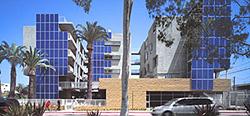 Prevailing breezes will cool the building, which will have no mechanical air conditioners. The U-shaped structure ‘acts like a giant wind scoop,’ said architect Larry Scarpa, a principal of Santa Monica-based Pugh & Scarpa.
Prevailing breezes will cool the building, which will have no mechanical air conditioners. The U-shaped structure ‘acts like a giant wind scoop,’ said architect Larry Scarpa, a principal of Santa Monica-based Pugh & Scarpa.
In yet another ‘green’ flourish, the building will collect all the rainwater from the alley behind the property and funnel it into a series of underground chambers. The water will slowly percolate back into the soil, which will filter the pollutants from the water while preventing contaminated water from spilling into Santa Monica Bay. The drainage system was paid for separately by the city of Santa Monica.
The concept of a building that would be energy self-sufficient emerged about two years ago, when Santa Monica officials met with members of the California Energy Coalition. The city’s Housing Division, which funds construction of low-income housing, chose to make a low-income housing project into a dream project of ‘green’ construction, and Colorado Court became the target.
‘We needed a demonstration project because a lot of developers feel that the technologies are unproven,’ Raida said.
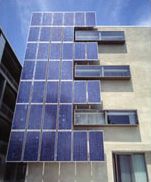 A number of apartment buildings in Santa Monica and Irvine are to be equipped with energy-saving technology by the Regional Energy Efficiency Initiative, but the Santa Monica building is the only project attempting to provide its own power as well.
A number of apartment buildings in Santa Monica and Irvine are to be equipped with energy-saving technology by the Regional Energy Efficiency Initiative, but the Santa Monica building is the only project attempting to provide its own power as well.
Rebates from the state Energy Commission helped defray the high cost of the energy-generating equipment. The state’s rebate on the solar panels, which cost about $225,000, will be about $62,000. The $57,000 micro-turbine and heat exchanger will yield a $15,000 rebate from Southern California Gas Co.
If recent research and development has yielded new ways of conserving energy and producing electricity, regulations and building codes have not kept pace.
In one instance, architects had to obtain special permission from the city to hang solar panels outside the exterior stairwells because building inspectors said the solar panels ‘enclosed’ the stairwells and triggered requirements for floors, ceilings and fire-rated walls.”
Santa Monica Mirror, December 6-12, 2000:
“[Architects] Pugh Scarpa Kodama and the Community Corporation have been working with the City of Santa Monica and Southern California Edison to come up with an ‘incentive-type’ plan, which would allot a certain amount of energy to each resident per month, and would award those who did not use the full amount with rebates on their energy bills....
Colorado Court’s units will rent for between $316 and $365. They will be available to low-income residents culled from the Community Corp’s waiting list, who meet the low-income requirements for this building. Twenty-two units will be rented to people making less than $12,775 yearly, another 22 to those making less than $14,600 yearly (these figures are based on 35 - 40% of the current median income of $36,500). According to Raida, the typical demographic for a building such as Colorado Court would include full time workers earning minimum wage, and people on fixed incomes such as retirees and the disabled.
The Community Corp’s waiting list currently numbers over 1,000 people.”
It’s great that the org’s and the city could pull together $5.8 million to build high-tech, green, low-income housing. But, experimenting on the poor for their demonstration project? Is this the flip side of environmental racism? Get some low-income tenants to live inside your the unproven technology? No air conditioning in Southern California? An experimental powerplant in the basement, and less-than-fire-rated exterior walls... that cover a fire exit? Evangelical indeed.
Stylish Housing that Fights Pollution
 How do you turn massive liability into a premium asset? Green, green, green.
How do you turn massive liability into a premium asset? Green, green, green.
Take contaminated industrial brownfield, haul away 5 feet of poisonous dirt, add architecture and planning firm, solar heating, wind power, green roofs, gardens that extract pollutants from the soil, huge argon-insulated windows, a view of the coastline and Web accessible remote control.
Then stand back and marvel at the chic elegance of Tango, a designer housing complex in Malmo, Sweden. The complex also recycles its waste water into a rebuilt marsh ecology that mimics the development’s east side, the marshy ecology of the sound. In passing the article mentions that the construction methods and materials were “hewed to ecological building standards that Malmo had set for the district.”
It’s all very geeky and cool, but I look forward to the day when sustainable design is boring and mandated outside of northern Europe, too, not just left to showcase projects that benefit those that can rent at three times the market rate or that make great PR when they pave over industrial contamination.
Solar-Powered Vaccine Refrigeration
Search Google for “rural vaccine refrigerators” and all kinds of solar energy projects pop up. Most recently, in June 2002 Kyocera Solar Inc. announced “the worlds most economical solar-powered vaccine refrigeration system.” The refrigerators make it possible to expand the reach of vaccines to areas not presently served. Extra insulation keeps contents cool and improves battery life. Read the press release or download the PDF brochure.
Sydney’s Green(ish) Games
The 2000 Summer Olympics in Sydney were to be the first “Green Games” because of the comprehensive environmental plan included in the city’s successful bid to the International Olympic Committee. The city’s guidelines
“recognise the major environmental issues of global warming, loss of biodiversity, ozone depletion and air and water pollution. They contain commitments in five main areas: energy conservation; pollution avoidance; water conservation; protection of the natural environment, and waste minimisation and management.”
Green Games Watch 2000 has a detailed account of the successes and failures of the event.
“The main green wins include public transport access, solar power applications, good building material selection, recycling of construction waste, progressive tendering policies, energy and water conservation and wetland restoration. The main green losses include the failure of most sponsors to go green, poor quality Olympic merchandising, environmentally destructive refrigerant selection, loss of biodiversity in some projects, failure to clean up contaminated Homebush Bay sediments in time for the Games and the lack of transparency and effective public consultation by the Olympic Coordination Authority and Sydney Organising Committee for the Olympic Games.”
See also two critical articles published in Harper’s and Current Affairs.
Solar Heating, USA
According to the 2000 Census, Eldorado, New Mexico has the nation’s highest percentage of homes heated mainly by solar power: 13.2 percent. The numbers are pretty dismal: “According to the census, the number of U.S. homes heated primarily by solar energy fell from 54,536 in 1990 to 47,069 a decade later. Federal and many state tax credits for solar homes have long since dried up.” As of 2000, Eldorado had 317 solar homes. Also of note, 8 of the 10 cities are in Hawaii.
page 2 1


